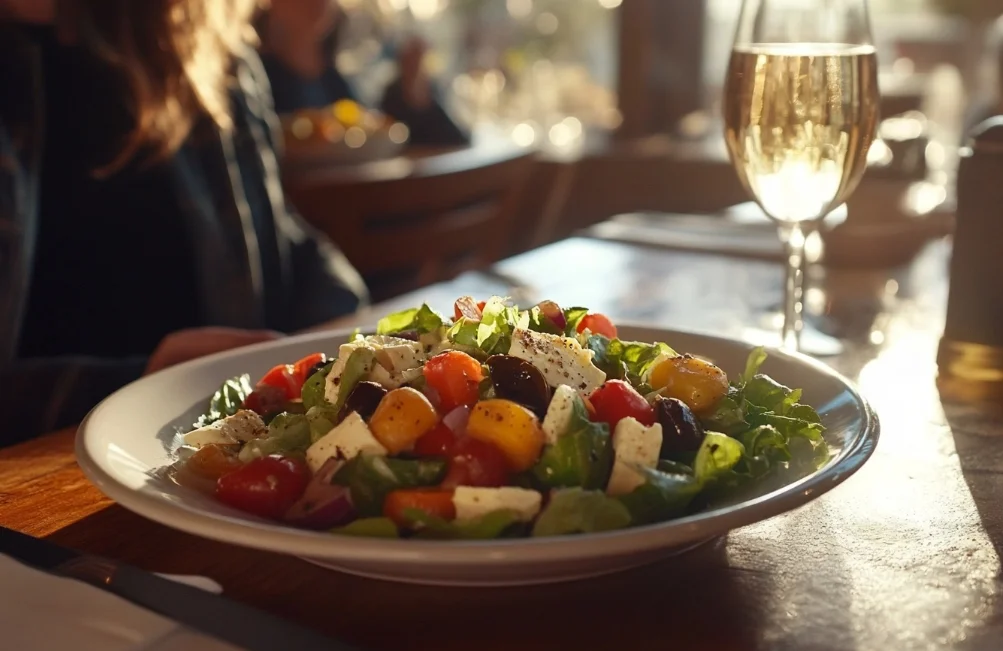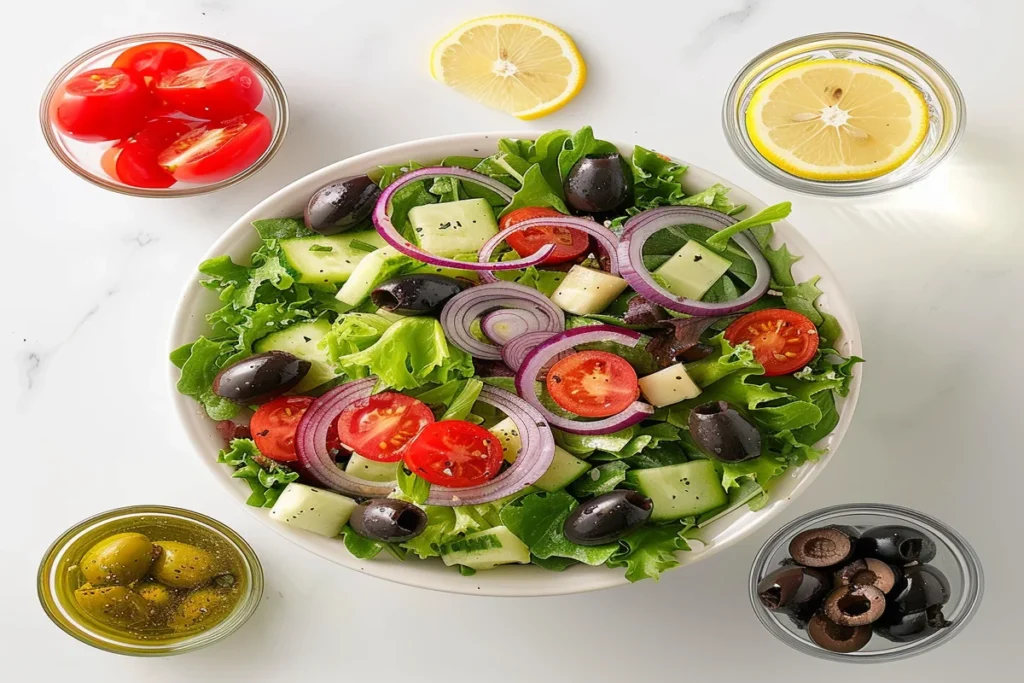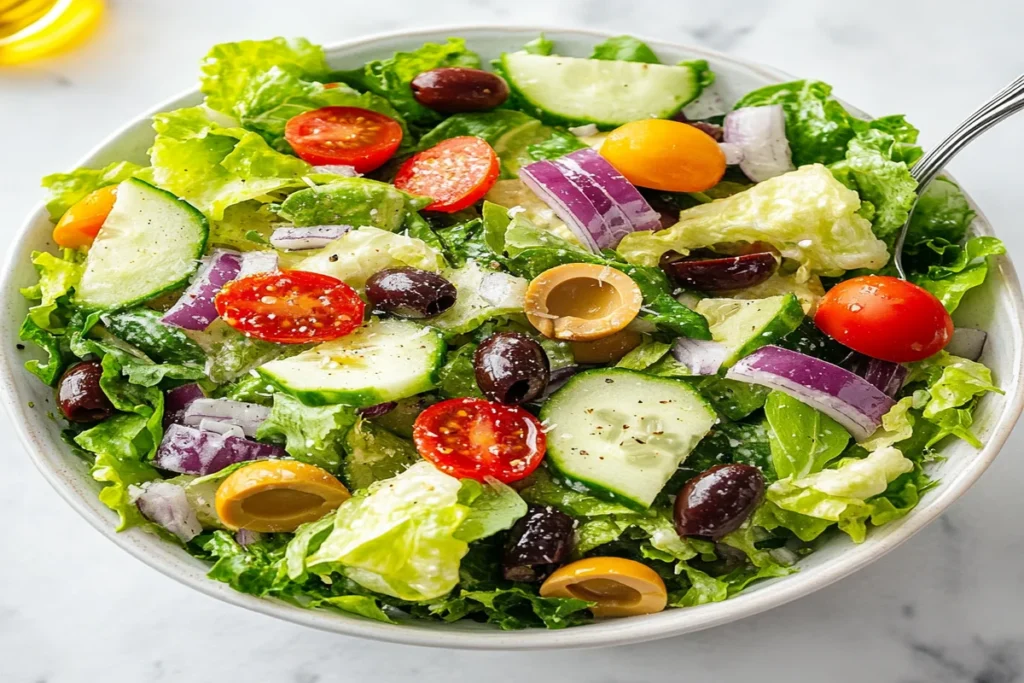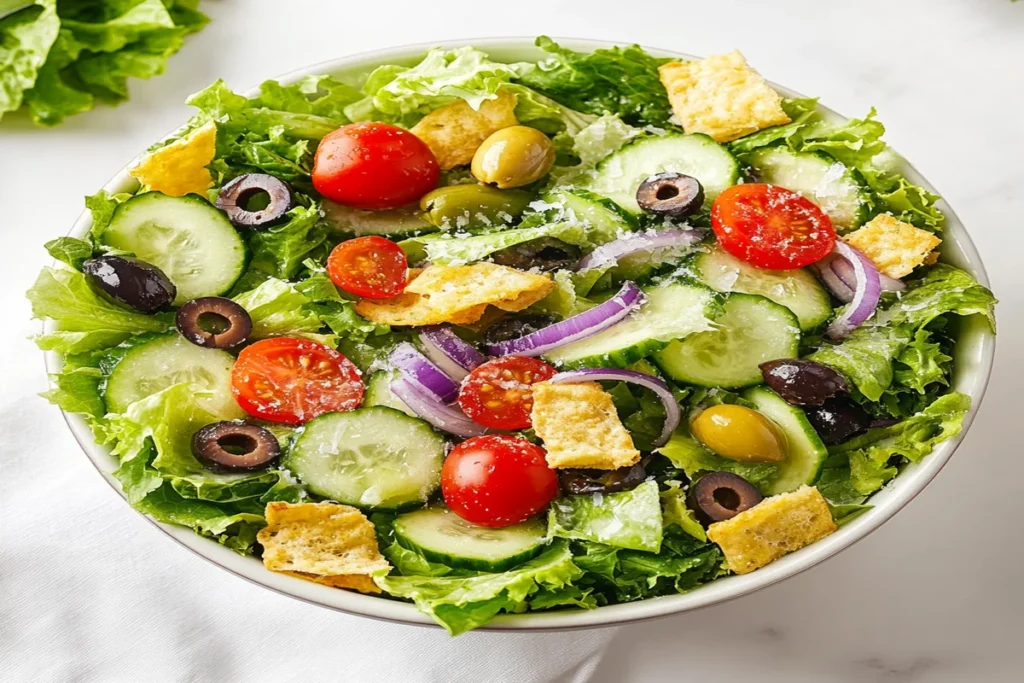Table of Contents
Introduction
The Olive Garden Salad has become a beloved dish for many. This refreshing salad, with its crisp veggies and zesty dressing, is a classic favorite at Olive Garden restaurants. But did you know you can easily recreate this dish at home? In this article, we’ll walk you through the step-by-step process to prepare the perfect Olive Garden Salad, complete with all the essential ingredients and a homemade dressing. Whether you’re serving it as a side or enjoying it as a light meal, this salad is sure to impress.

Part 1: The Essential Ingredients for the Olive Garden Salad
To make an authentic Olive Garden Salad at home, you’ll need a variety of fresh ingredients. The combination of crisp greens, tangy olives, savory croutons, and a delicious dressing is what makes this salad so irresistible. Let’s dive into what you’ll need for your homemade version.
Key Ingredients
Here’s a list of the main ingredients you’ll need to create the perfect Olive Garden Salad:
- Romaine Lettuce – This is the primary leafy green for your salad. It adds crunch and a slight bitterness, balancing the other flavors.
- Iceberg Lettuce – A classic addition, iceberg lettuce adds more crunch and a mild flavor, making the salad refreshing.
- Tomatoes – Ripe, juicy tomatoes bring sweetness and color to the salad.
- Cucumbers – Crisp and refreshing, cucumbers add a cool element to the mix.
- Red Onions – Thinly sliced red onions add a bit of sharpness and flavor.
- Pepperoncini Peppers – These give the salad a spicy kick, offering a unique contrast to the fresh vegetables.
- Black Olives – Rich, briny black olives are a must for that signature Olive Garden Salad taste.
- Croutons – Fresh, crunchy croutons add texture and flavor to the salad.
- Parmesan Cheese – A generous sprinkle of grated Parmesan cheese gives the salad an extra umami punch.
For the Homemade Italian Dressing
To achieve the zesty, tangy flavor that Olive Garden is known for, you’ll need the following ingredients for your homemade dressing:
- Olive Oil – The base of your dressing, offering richness and smoothness.
- Red Wine Vinegar – This adds acidity and brightness to the dressing.
- Garlic Powder – For that savory, aromatic flavor that ties everything together.
- Dried Oregano – A must-have for an authentic Italian touch.
- Dried Basil – Adds a subtle herbal note.
- Sugar – A pinch of sugar balances out the acidity of the vinegar.
- Salt and Pepper – For seasoning, to taste.

Part 2: Step-by-Step Instructions for Making Olive Garden Salad
Now that you’ve got all the ingredients ready, it’s time to assemble your salad. Let’s break it down step by step so you can recreate the perfect Olive Garden Salad at home.
Step 1: Prepare the Vegetables
Start by washing all your vegetables thoroughly. For the romaine and iceberg lettuce, remove any wilted or damaged leaves. Cut the lettuce into bite-sized pieces, then place it in a large salad bowl.
- Tomatoes: Slice the tomatoes into wedges or small chunks.
- Cucumbers: Peel (if desired) and slice the cucumbers thinly.
- Red Onions: Slice the red onions into thin rings. You can soak the slices in cold water for a few minutes to reduce their sharpness, if preferred.
Once everything is prepared, add the tomatoes, cucumbers, and onions to the lettuce in the bowl.
Step 2: Add the Pepperoncini, Olives, and Croutons
Now, it’s time to add the Olive Garden signature ingredients:
- Pepperoncini Peppers: Tear off the stems and add a few pepperoncini peppers to the salad. If you want a spicier salad, you can add more.
- Black Olives: Add a handful of black olives to the salad for that briny flavor.
- Croutons: Sprinkle a generous amount of croutons over the salad for extra crunch and flavor.
Step 3: Make the Italian Dressing
To make the dressing, combine the following ingredients in a bowl or jar:
- ½ cup of olive oil
- 3 tablespoons of red wine vinegar
- 1 teaspoon of garlic powder
- 1 teaspoon of dried oregano
- 1 teaspoon of dried basil
- 1 teaspoon of sugar
- Salt and pepper to taste
Whisk all the ingredients together until fully combined, or shake them in a jar until the dressing emulsifies.
Step 4: Dress the Salad
Drizzle the homemade dressing generously over the salad. Toss the ingredients gently to coat them evenly. Be careful not to overdress the salad; you can always add more if needed.
Step 5: Add Parmesan Cheese
Finish by sprinkling a generous amount of grated Parmesan cheese over the top of the salad. This adds that signature Olive Garden Salad flavor.

Customizing Your Olive Garden Salad for Different Diets
The Olive Garden Salad is versatile and can be customized to suit different dietary preferences. Whether you’re looking for a vegan, gluten-free, or low-carb version, you can make simple modifications to suit your needs. Let’s explore how you can personalize your salad while keeping the flavors intact.
Vegan Version of Olive Garden Salad
Making your Olive Garden Salad vegan-friendly is simple! Since the original recipe includes Parmesan cheese and Italian dressing with dairy, you can easily swap those ingredients for plant-based alternatives.
- Vegan Parmesan: Replace the regular Parmesan cheese with a plant-based, vegan Parmesan cheese. You can find vegan Parmesan at most grocery stores or make your own by blending cashews, nutritional yeast, and garlic powder.
- Dairy-Free Dressing: Use a dairy-free Italian dressing instead of the original, which typically contains milk or cheese. There are many vegan dressings available on the market, or you can make your own by mixing olive oil, vinegar, garlic powder, and herbs.
By making these adjustments, you can enjoy the same fresh, flavorful salad while adhering to a vegan lifestyle.
Gluten-Free Version of Olive Garden Salad
For those who follow a gluten-free diet, it’s important to ensure that the croutons are gluten-free. You can easily swap the regular croutons for gluten-free ones, or, if you prefer, skip the croutons entirely.
- Gluten-Free Croutons: Many grocery stores offer gluten-free croutons, or you can make your own at home using gluten-free bread. Simply cut the bread into cubes, toss it with olive oil and seasoning, and bake until crispy.
Incorporating gluten-free croutons or omitting them will allow you to enjoy a safe and delicious salad without worrying about gluten.
Low-Carb Version of Olive Garden Salad
If you’re following a low-carb or keto diet, you can reduce the carb content of your Olive Garden Salad by skipping the croutons entirely, as they are made from bread. Additionally, focus on the fresh vegetables and add a protein source like grilled chicken or shrimp to keep the meal balanced and filling.
- Protein Options: Consider adding grilled chicken, shrimp, or even tofu to increase the protein content and make your salad more satisfying. These additions provide a good balance of nutrients without adding excessive carbs.
- Skip the Croutons: While croutons provide crunch, they are also a source of carbohydrates. Removing them will significantly reduce the carb count, making it a perfect option for those on a keto or low-carb diet.
These easy swaps allow you to enjoy a healthy, low-carb version of the Olive Garden Salad without compromising on flavor.
Part 3: How to Pair Olive Garden Salad with Other Dishes
The Olive Garden Salad is a great side dish, but it can also be paired with various main courses to create a well-rounded meal. Whether you’re serving it alongside Italian classics or lighter fare, it complements a wide range of dishes. Let’s take a look at some of the best ways to pair this salad for a complete dining experience.
Pairing with Pasta Dishes
One of the best ways to enjoy your Olive Garden Salad is by pairing it with a delicious pasta dish. Olive Garden is known for its variety of pasta options, and the crisp, refreshing salad acts as the perfect balance to rich, creamy sauces.
- Fettuccine Alfredo: This creamy, indulgent pasta dish pairs beautifully with the tangy and fresh Olive Garden Salad. The acidity from the salad dressing helps cut through the richness of the Alfredo sauce.
- Spaghetti Bolognese: A hearty, meaty pasta dish like spaghetti with Bolognese sauce is another great match. The salad offers a refreshing contrast to the heavy sauce, making each bite feel lighter.
Pairing with Grilled Meats
The fresh, crunchy texture of the Olive Garden Salad also works wonderfully with grilled meats. The salad’s vibrant flavors enhance the smoky, savory taste of the meat.
- Grilled Chicken: Whether it’s grilled chicken breasts, thighs, or skewers, the Olive Garden Salad makes the perfect accompaniment. The freshness of the salad complements the savory flavors of grilled chicken, creating a satisfying meal.
- Grilled Steak: For a more indulgent meal, pair your salad with a juicy grilled steak. The salad’s lightness helps balance the rich, meaty flavors of the steak.
Pairing with Seafood
Seafood and salad go hand in hand, and the Olive Garden Salad is no exception. The salad adds a refreshing contrast to the delicate flavors of fish or shellfish.
- Grilled Shrimp: Add grilled shrimp to your salad for a protein-packed, light, and refreshing meal. The briny olives and tangy dressing pair beautifully with the sweetness of the shrimp.
- Salmon: A perfectly grilled or baked salmon fillet is another excellent choice. The salad provides a fresh, crunchy texture that complements the smooth, rich taste of salmon.
Vegetarian Pairings
For those who prefer a plant-based meal, the Olive Garden Salad can be paired with a variety of vegetarian options. From vegetable soups to veggie-packed pastas, the salad’s versatility shines through.
- Vegetable Soup: Serve the salad alongside a warm bowl of vegetable soup for a light and wholesome meal. The combination of hot soup and cool salad is both comforting and refreshing.
- Pasta Primavera: A pasta dish loaded with fresh vegetables and olive oil is a perfect companion for the Olive Garden Salad. The salad adds a fresh crunch to complement the tender pasta and vegetables.
Part 4: The History Behind the Olive Garden Salad
The Olive Garden Salad has become a staple in many homes and restaurants across the world. But how did this iconic dish come to be? Understanding the history behind the salad can give us a deeper appreciation for its flavors and cultural significance.
The Birth of Olive Garden
Olive Garden was founded in 1982 by Bill Darden and has since grown into one of the largest Italian restaurant chains in the United States. From the beginning, the restaurant focused on offering delicious, homestyle Italian food that felt both comforting and indulgent. The Olive Garden Salad was a key part of their menu offering, representing the fresh, vibrant ingredients found in traditional Italian cuisine.
The salad quickly became a fan favorite, known for its combination of crisp greens, flavorful vegetables, and tangy dressing. With the addition of fresh Parmesan cheese and crispy croutons, the salad became the perfect starter to a hearty Italian meal.
The Famous Olive Garden Salad Dressing
What sets the Olive Garden Salad apart from other salads is its unique Italian dressing. Made with a blend of olive oil, red wine vinegar, garlic, and herbs, this dressing adds a rich, tangy flavor that enhances the freshness of the vegetables. While the dressing is available for purchase at many grocery stores, making it fresh at home can give you a taste that’s even more authentic.
The dressing’s balanced flavor profile, combining acidity and richness, is a hallmark of traditional Italian cuisine. It ties the salad together, bringing out the best in each ingredient while making it a memorable part of the dining experience.

The Salad’s Popularity
As Olive Garden grew in popularity, so did its salad. Over the years, the Olive Garden Salad has become a symbol of the chain’s commitment to serving fresh, high-quality ingredients. Today, it remains one of the most beloved items on the menu, often praised for its simple yet satisfying combination of ingredients.
Not only is it a popular starter in Olive Garden restaurants, but it’s also a go-to recipe for those who want to bring a taste of Italian dining into their own kitchens. Whether served with pasta, grilled meats, or seafood, the Olive Garden Salad is a versatile dish that can be enjoyed in many different ways.
Part 5: Tips for Storing and Preserving Your Olive Garden Salad
To make sure your Olive Garden Salad stays fresh and delicious, proper storage is key. The salad, especially with the homemade dressing, can be easily preserved if you follow a few simple tips.
Storing the Salad Greens
Fresh greens like romaine and iceberg lettuce should be stored in the refrigerator in an airtight container. To help them last longer, place a dry paper towel inside the container to absorb any excess moisture. This will prevent the leaves from wilting or becoming soggy.
If you’re prepping the salad ahead of time, it’s best to store the vegetables separately from the dressing and croutons. Tossing the salad too early will cause the greens to wilt, and the croutons will lose their crispiness.
Storing the Dressing
If you’ve made your own homemade Italian dressing, store it in an airtight jar or container in the refrigerator. The dressing should stay fresh for up to a week, so you can use it for multiple salad servings. Just give it a good shake before using, as the ingredients may separate over time.
Storing the Croutons
Croutons are best stored in a dry, airtight container at room temperature. If you’ve made homemade croutons, you can also freeze them for longer storage. Be sure to keep them in a freezer-safe bag or container to maintain their crunchiness.
How Long Can You Keep a Prepared Salad?
Once the salad has been tossed with the dressing, it’s best to eat it right away for optimal freshness. However, if you need to store a dressed salad, it can last for about 1–2 days in the refrigerator. Keep in mind that the lettuce will begin to wilt, so it’s recommended to store the salad in an airtight container and consume it as soon as possible.
Part 6: Why Olive Garden Salad is a Perfect Side for Any Meal
The Olive Garden Salad is the perfect addition to nearly any meal. Its balance of fresh vegetables, tangy dressing, and savory croutons make it a versatile side dish that complements various main courses. Let’s explore why it’s so universally loved.
A Light and Refreshing Side
Salads, in general, are great for lightening up heavier meals. The Olive Garden Salad provides a refreshing contrast to rich and filling dishes like pasta, steak, and fried foods. The crisp veggies and the tangy dressing provide a satisfying bite without leaving you feeling too full.
Balancing Heavier Main Dishes
When paired with creamy pasta dishes like Fettuccine Alfredo or Lasagna, the Olive Garden Salad works wonders in cutting through the richness of the main course. The acidity from the vinegar and the crunchiness of the vegetables help balance out the heaviness, making it easier to enjoy multiple courses without feeling overly stuffed.
A Healthy and Wholesome Option
The Olive Garden Salad is an excellent choice for those who want to eat something fresh and nutritious. With its mix of lettuce, tomatoes, cucumbers, and olives, it provides a good amount of fiber, vitamins, and antioxidants. When you serve it as a side, it adds a healthy boost to your meal without compromising on flavor.
Great for Sharing
The family-style serving of Olive Garden Salad is perfect for sharing with friends or family. The large portions make it ideal for group meals, and the salad can easily be paired with various dishes to accommodate everyone’s tastes.
Part 7: Olive Garden Salad for Special Occasions and Gatherings
The Olive Garden Salad isn’t just for regular meals—it’s a fantastic choice for special occasions and gatherings. Whether you’re hosting a family dinner, a holiday celebration, or a casual barbecue, this salad is sure to impress guests and elevate your meal. Let’s explore how you can incorporate the Olive Garden Salad into various events and gatherings.
Perfect for Family Dinners
Family dinners are all about sharing a great meal together, and the Olive Garden Salad is perfect for this. With its generous portions, you can serve it family-style, allowing everyone to help themselves. Its freshness and balance of flavors make it a great start to a multi-course meal, especially when paired with pasta dishes or grilled meats.
The salad’s ingredients are simple yet satisfying, and it’s easy to prepare in large quantities. This makes it an ideal choice for busy families who want to enjoy a delicious, nutritious side dish without spending too much time in the kitchen.
A Hit at Holiday Celebrations
The Olive Garden Salad is also an excellent addition to holiday spreads. Whether you’re celebrating Thanksgiving, Christmas, or a special birthday, this salad brings a refreshing balance to more indulgent dishes like turkey, ham, or mashed potatoes. The vibrant colors of the salad will brighten up your holiday table, while the tangy dressing adds a unique touch to the usual holiday fare.
You can also customize the salad to suit the occasion. For example, you can add seasonal ingredients like roasted squash in the fall or fresh berries in the summer, giving the salad a festive twist that reflects the season.
A Crowd-Pleaser for Barbecues and Picnics
For outdoor events like barbecues or picnics, the Olive Garden Salad is a crowd-pleaser. Its fresh ingredients and light dressing make it a great complement to grilled meats and sandwiches. Plus, it’s easy to prepare ahead of time, so you don’t have to worry about last-minute prep when guests arrive.
Pair the salad with grilled chicken, burgers, or a veggie platter for a wholesome meal that’s both satisfying and refreshing. The salad is also easy to transport, making it a perfect dish for potlucks and gatherings where food needs to be shared.
Impressing Guests at Dinner Parties
If you’re hosting a dinner party, the Olive Garden Salad can add a touch of elegance to your menu without requiring too much effort. Serve it as a first course, alongside freshly baked bread or appetizers, to whet your guests’ appetites before the main course. The combination of fresh veggies, croutons, and a tangy dressing will leave your guests feeling refreshed and ready for the meal to come.
You can even add a personalized touch by including unique ingredients that reflect the theme of your dinner. For example, adding fresh mozzarella or roasted vegetables can elevate the flavor profile, making it even more memorable.
Part 8: FAQs About Olive Garden Salad
1. Can I make Olive Garden Salad ahead of time?
Yes! You can prep the vegetables in advance and store them in the fridge for up to a day before serving. However, it’s best to wait until just before serving to add the croutons and dressing to keep everything fresh.
2. Is the Olive Garden Salad gluten-free?
The salad itself is gluten-free, but the croutons are not. If you’re following a gluten-free diet, simply skip the croutons or use gluten-free croutons instead.
3. How long does the homemade Italian dressing last?
If you make the Italian dressing at home, it will last for about 1 week in the refrigerator when stored in an airtight container. Just be sure to shake it well before each use, as the ingredients may separate over time.
4. Can I make the salad vegan?
Yes! To make the Olive Garden Salad vegan, simply omit the Parmesan cheese or replace it with a vegan Parmesan alternative. You can also use a plant-based dressing for a completely vegan-friendly salad.
5. What other toppings can I add to the Olive Garden Salad?
Feel free to add any extra toppings to customize your salad! Grilled chicken, shrimp, or even bacon (if not avoiding it) can make the salad a more filling meal. You can also add roasted vegetables or extra cheese, like feta, to elevate the flavor.
Part 9: Why You Should Make Olive Garden Salad at Home
While enjoying an Olive Garden Salad at the restaurant is a treat, making it at home offers several advantages. Not only can you adjust the recipe to suit your personal tastes, but you can also ensure the ingredients are fresh and of high quality. Plus, preparing the salad yourself allows you to customize the ingredients and make it your own.
Control Over Ingredients
When you make the Olive Garden Salad at home, you get to choose exactly what goes into it. This means you can opt for organic vegetables, fresh herbs, and high-quality olive oil. Additionally, you can adjust the seasoning to suit your taste, whether you like it extra tangy or with more of a savory kick.
Cost-Effective
Making your own Olive Garden Salad can also be more cost-effective than ordering it at the restaurant. The ingredients are affordable, and you can make multiple servings for a fraction of the price. Plus, the homemade dressing is much cheaper than purchasing pre-made options.
Freshness
One of the best reasons to make the salad at home is the freshness. You can prepare the vegetables just before serving, ensuring they stay crisp and vibrant. This gives your salad the same fresh, crisp taste that you would enjoy at Olive Garden, but in the comfort of your own kitchen.


1 thought on “Olive Garden Salad at Home”